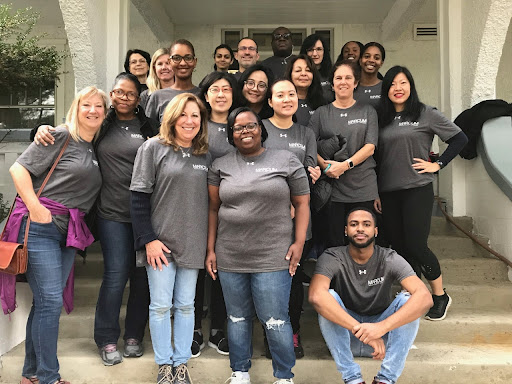 This article is part of our 2022 contribution to the Homeless Crisis Reporting Project in collaboration with other local newsrooms. The collective works will be published throughout the week at homelesscrisis.press.
This article is part of our 2022 contribution to the Homeless Crisis Reporting Project in collaboration with other local newsrooms. The collective works will be published throughout the week at homelesscrisis.press.
In 1982, Stepping Stones Shelter made history as the first homeless shelter for families in Montgomery County, MD. Today, it’s best known for its location in Rockville’s historic Dawson Farmhouse and for providing about 30 families with housing and services each year.
Stepping Stones houses families of all shapes and sizes; two-parent families, single parents, multigenerational households and anyone with custody of a minor. The shelter’s Hope Housing Program also provides permanent supportive housing for two families with disabled heads of household. Stacey Gold, Stepping Stones’ executive director, has navigated five years of growth and change at the shelter. Street Sense Media spoke with Gold about carrying on the shelter’s legacy.
Describe an experience you’ve had at Stepping Stones that captured the essence of the shelter.
There was a day when our copier broke and I had to call the copier company. I dialed in and I gave them our number, which is connected to the organization’s name. The lady I was talking to types in the number and was very businesslike the whole time. Then, I could see her leaning into the phone and she whispers to me, “Oh, Stepping Stones. I used to live there.” I was so proud of her at that moment because she was working. That’s what we want. I want to hear that a family — that at one time had nothing — is now working for a company. I asked her how she’s been doing and how her family is and we talked about it. It was a sweet story.
How has family homelessness in Montgomery County changed since Stepping Stones was created?
I think families without knowledge of the system thought that they were going to get their kids taken away because they had no place to live. There are now two other shelters in Montgomery County that do what we do. They provide a safe place for families to stay together and work out the issue of being unhoused and figuring out how they’re going to move forward. In my time here, the biggest change has been the Housing First model. When I first got here, how you do things was much more punitive as far as what you can and cannot do in order to access shelter. Housing First has been the biggest change in the family shelters and all the shelters.
What’s the significance of running a family homeless shelter in the Dawson Farmhouse?
It was built by the Dawson family, who for generations, dating back to the Civil War, was a prominent family in Rockville. The matriarch built the house and the way the story goes —- it’s a huge home—- is that the main level is really for family and the second floor, which I call the resident hall, was for guests and people who were passing through and needed a place to stay. That was in 1912. Eventually, it became a private home and we bought it in 1982. In a different way, we’ve stayed really true to that mission of welcoming people who need a place to stay.

How many families currently live at Stepping Stones Shelter?
We have six rooms which allows us to have six families. We have five right now and one coming in today so we’ll be full. Each room is a different size, so we have a family as small as mom and baby, and then a room with a bunch of bunk beds that can fit ten.
Walk me through the process of staying at Stepping Stones. What’s the length of an average stay?
It’s been 60 to 90 days. (A family will) come in, they’ll bring their stuff, and we hit the ground running. They’ll do an intake with our case manager that consists of two things: gathering some level of information about the family and orienting them to the shelter. We show them the house — the kitchen, the laundry room. They go through the resident handbook.
After that happens, they move into a room. We have prepared their room in accordance with who’s coming in the family. Every room is customized. Books are placed in the room, stuffed animals. We try to make it so that when they walk in, they just breathe in a sigh of relief. There’s no more couch surfing, no more hotels. It’s clean and warm and friendly. Then after that, I say the real work begins, and that’s really where the case manager works with the family to identify all the barriers to obtaining stable housing and starts chipping away at those barriers.
Tell me about the relationship between Stepping Stones and families after they’ve passed through the organization’s doors.
We help our families in any way they need. Some families leave the shelter with a case manager who checks on them once a month. We do establish relationships with our families. Many of them come to trust the services and the people here. We are blessed with a robust donor base who bring so many goods here so that we’re able to meet the needs of families when they live here. When families leave, they fill out a wish list and we pack them up pots and pans and things like that. It’s not uncommon that a family might call and say “I’m running low on groceries, do you have food?” We will do our very best. We also have initiatives. We have Thanksgivings, school supplies that we give out, we invite our post-shelter families back to shop in our boutique to get gifts (at Christmas). Every time we have a point of contact, it’s an opportunity to talk to them. A lot of times, we identify who’s at risk of losing their housing, and the case manager and director of operations will start intervening on their behalf with the county. We’re all in it together.

Montgomery County is the wealthiest county in Maryland and one of the wealthiest in the United States. How effectively are families able to navigate living in Montgomery County after their time at Stepping Stones? How many leave the county?
Even though the county is generous and really cares for families and people in need, it’s expensive to live here. But people want to live here. They want their kids in the school system, so they work very hard to find a way. I know of a handful of our residents who have gone to Frederick and I know another who’s been back and forth to North Carolina. The most important thing to us is that we don’t want anybody to return to homelessness. In my time, I’ve seen maybe ten families return to homelessness. They may not come back here but I’m aware that they’re in the system.
How has the COVID-19 pandemic affected demand for your services and your ability to meet this demand?
During Covid, we stayed open 24/7. While we had a steady flow of families, it was quieter during Covid as far as the number of families who were coming into the shelter. I think families and friends were much more sympathetic and allowed people to stay with them. Nobody wanted to come into a congregate setting during Covid, and there was the eviction moratorium. Once the eviction moratorium lifted, the families started coming through more and more.
What are Stepping Stones’ goals for the coming year?
The goal is always to move somebody out as quickly as possible in a responsible way. The other part of that is to do more for our families while they’re in the shelter. Instead of broadening our scope to more formally serve our post-shelter families, we’ve decided to go deeper into how we help our families here at the shelter. The number one area is the workforce development stuff. Figuring out how a family can leave here with more skills and get them started on a path of doing more skills training. We want them to be working in a job that is going to pay them a little bit more so they can leave here and sustain their housing. That’s the goal. It’s very, very hard to achieve. But we’re going to try and we’re not going to stop.








